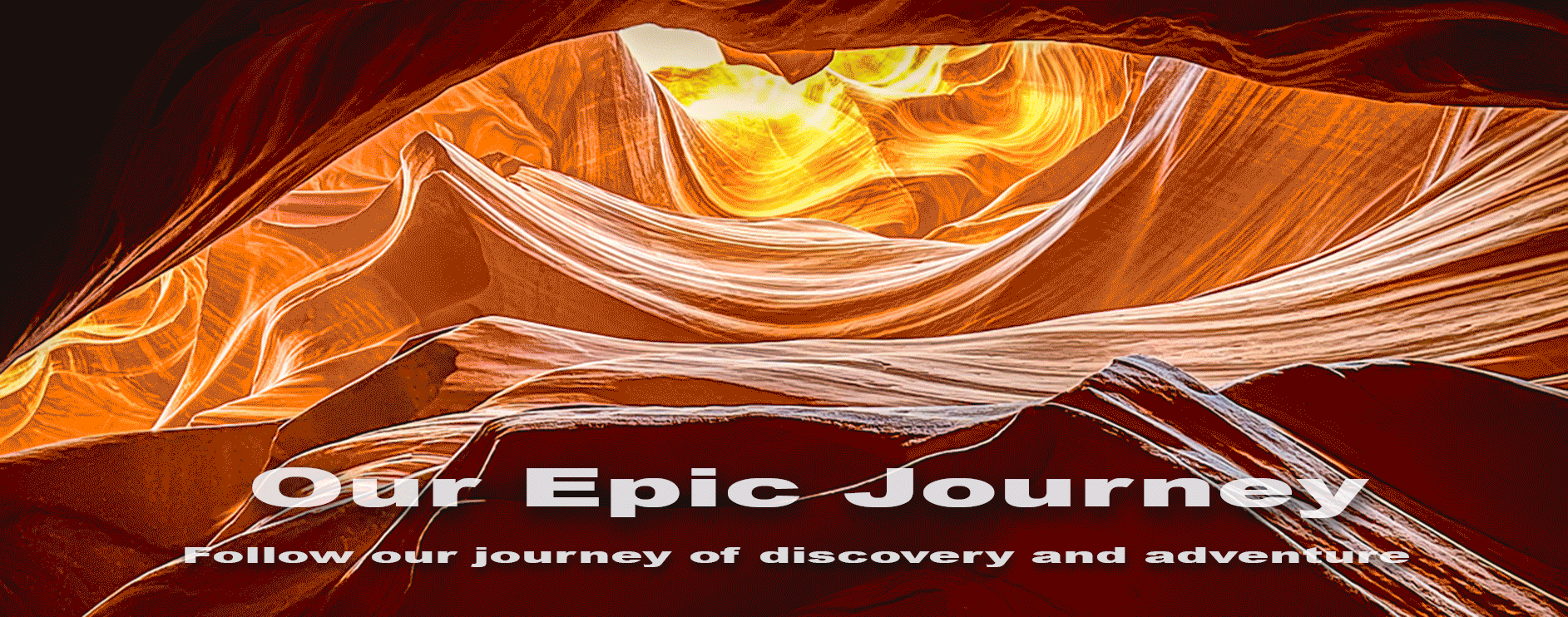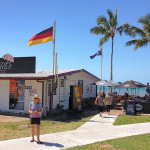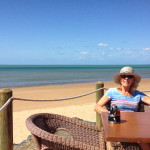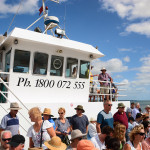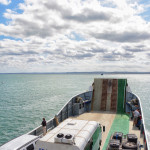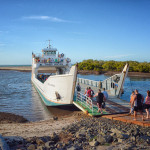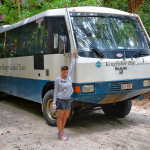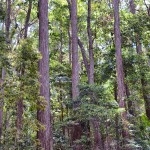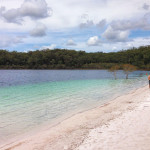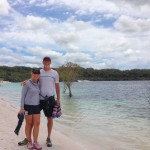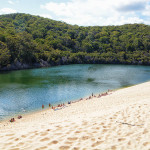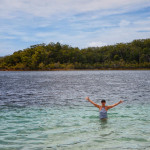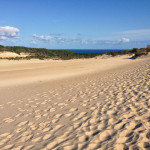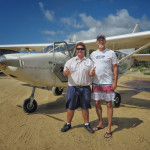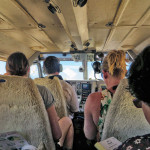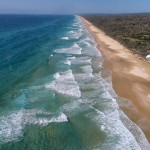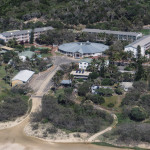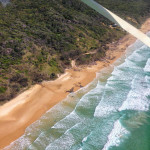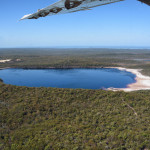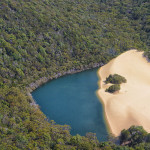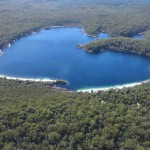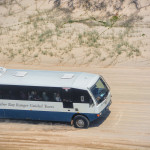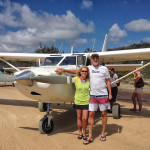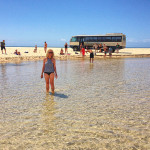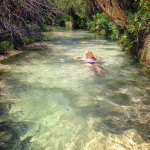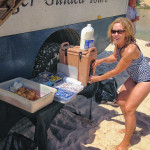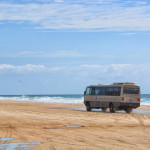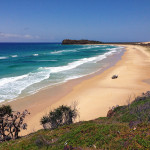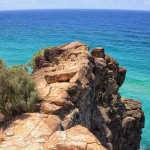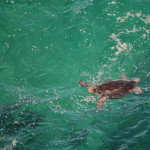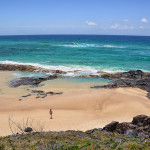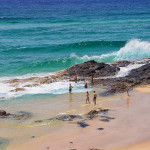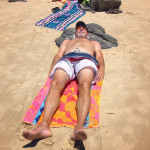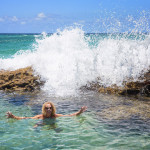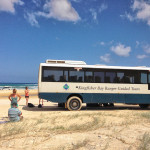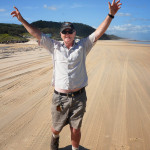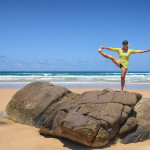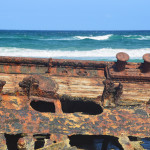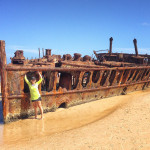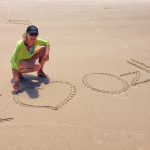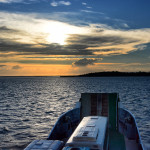November 3, Monday, we headed north to Hervey Bay, about a 4 hour drive from Dicky Beach. It is a natural bay between the mainland and Fraser Island, and the local economy is based on tourism, primarily whale watching and access to Fraser Island, the largest sand island in the world, that stretches over 76 miles in length and 13 miles at its widest point. Fraser Island beaches and sandy inland roads are suitable only for high clearance 4WD vehicles with low range capacity, so we could not take our car. We booked a two day tour leaving at 8am the next morning ready for another adventure in a 4WD tour bus carrying about 30 tourists from all over the world, a lot of Germans.
The ferry ride took about 2 hours to the Island where we began the bumpy ride on narrow sandy roads through the majestic remnants of tall rain forests growing on sand. It is the only place in the world where tall rain forests up to 165 feet high, are found growing on sand dunes at elevations of over 650 feet. Fraser Island was an Aboriginal Reserve from 1860 until it was revoked in 1906 and all the Aborigines were removed, then in 1908 it was declared a Forestry Reserve and the Island was lumbered heavily into the early 20th century. Our Guide told us that it was discovered in the 1930’s that the wood of the giant satinay trees, or the Fraser Island turpentine, was extremely resistant to rotting in water and they were felled and shipped off to ports around the world and many were used to line the Panama Canal. In 1971, Fraser Island became Great Sandy National Park and in 1992 all logging operations were stopped by FIDO and it was accepted as a natural World Heritage Site.
The Island has over 100 perched dune fresh water lakes, that are formed when organic matter, such as leaves, bark, and dead plants, gradually build up and harden in depressions created by the winds, and are dependent on rainfall for water levels. Lake McKenzie is the most popular and most picturesque perched lake where our guide took us first. The clear waters of Lake McKenzie in shades of white to dark blue are fringed by blindingly white sand beach and the water felt silky as we plunged into its depth. We stayed here for an hour enjoying the magnificence of this clear fresh water lake. Then we took a walk through the rainforest along a small creek before stopping for lunch. After another long bumpy ride we went for a swim in Lake Wabby, a small freshwater, green colored lake and the deepest lake on the island. It is an impressive barrage lake which form when water flows from a natural spring are blocked by a sand mass, the Lake is directly adjacent to the Hammerstone Sandblow which is slowly engulfing it. It was wonderful to cool off in these lakes because the weather was hot and sunny and it made for a nice break. Todays trip was nearly over, and we headed to the Eurong Beach Resort on the east side of the Island located on the 75 mile beach, where we are staying the night. We were warned not to swim in the ocean because of sharks, even though it looked very inviting.
The next morning started with a drive along the 75 mile beach when we came upon two planes. They asked us if anyone wanted to take a flight over Fraser Island and we jumped at the chance, of course it was extra. Fraser Island is one of two islands in the world where planes can land and take off from the beach. It was well worth the trip, to see ancient gravity defying rain forests, growing out of only sand, brilliant blue freshwater lakes and spectacular sand formations; definitely one of the most incredible islands on earth. Next we continued down the beach to Eli Creek, the largest fresh water creek on the eastern beach. Where we stopped for a dip in this pure water.
“The water in the creek is absolutely pure and up to 80 million liters of water a day flow from this natural aquifer into the sea. Its water considered one of the world’s purest, taking over 100 years to get filtered through the sand.”
Our Guide told us that it’s believed the aquifer beneath Fraser contains around 15 million mega liters of fresh water, to put that into perspective, the iconic Sydney Harbor in its entirety contains only 500,000 mega liters.
We walked up to the far end of the boardwalk to the bridge, jumped into the creek and swam or floated down the swiftly flowing creek back to the beach, it was a fun, and invigorating experience, so we did it again and again! As mentioned earlier swimming in the ocean is not recommended on the entire Eastern Beach of the Island. There are various dangers that may harm swimmers, such as strong rips and undertows, as well as sea stingers and sharks that infest the ocean. There is only one place where salt water swimming is allowed along the 75 mile beach, it is one of the Island’s treasures, the Champagne Pools, Fraser Island’s very own natural jacuzzi. The pools are fed by waves crashing over the top of the rocks into shallow sandy pools, and once the waves settle you are left with the fizzing foam…..hence champagne! We had a great time exploring these pools.
Video Tour of Fraser Island
Located at the end of 75 mile beach is the volcanic promontory known as Indian Head, a coastal headland and the most easterly point on the Island. It was named by Captain Cook in 1770 for the Aboriginal people he saw gathered there. “Indian” was the name for the native people back then. We climbed to the top of Indian Head where we had beautiful 360 degree views and good wildlife spotting. We saw large turtles swimming in the water far below us. On our way back along the beach we stopped to explore the wreck of the SS Maheno, meaning “island” in Maori. The SS Maheno, a 5,000 ton steel hulled ship, an ocean liner belonging to a company in New Zealand that operated the Tasman Sea from Australia to New Zealand between 1905 and 1935. It was also used as a hospital ship during WWI. During a severe cyclone in 1935 it was beached off the coast of Fraser Island, where it continues to disintegrate and rust.
Finally our tour is over and we have to head back to the west side of the Island to get the ferry over to Hervey Bay. Fraser Island is definitely one of the highlights of this trip to Australia and I highly recommend it to one and all.
It is easy to understand how the Island got its ancient Aboriginal name of K’gari, meaning paradise.
